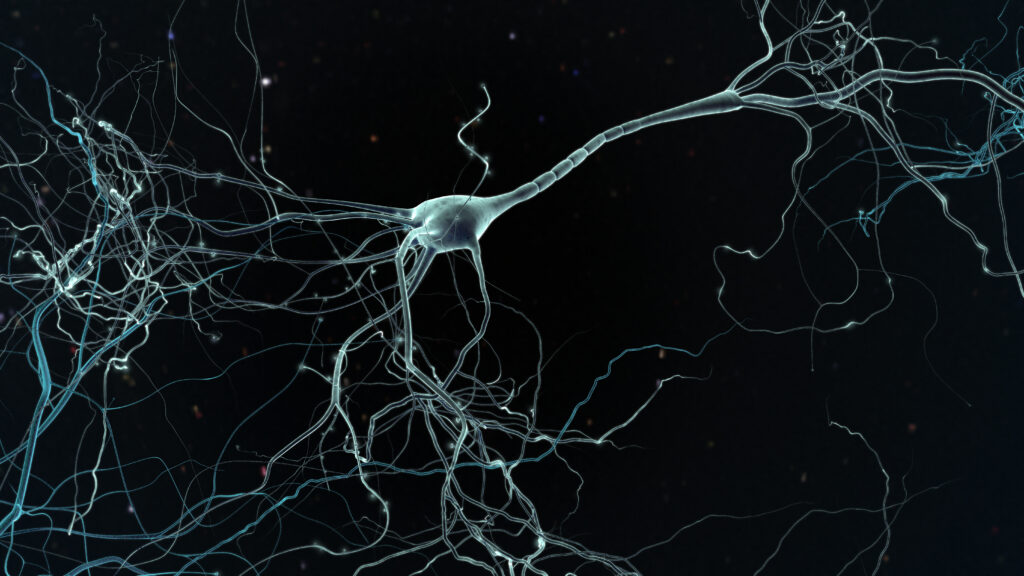For the first time, researchers have successfully demonstrated the ability to develop highly mature neurons from human induced pluripotent stem cells (iPSCs). The team behind the breakthrough is hopeful that their research will allow researchers to improve experiments and better understand neurodegenerative diseases like multiple sclerosis, Alzheimer’s, Parkinson’s, and amyotrophic lateral sclerosis (ALS).
Lab-Grown Neurons
The new study was published by a team of researchers led by Samuel I. Stupp, Board of Trustees Professor of Materials Science and Engineering, Chemistry, Medicine and Biomedical Engineering at Northwestern University, and Evangelos Kiskinis, assistant professor of neurology and neuroscience at Northwestern University Feinberg School of Medicine. Their research focused on determining if it was possible to create mature “lab-grown” neurons from stem cells. In past research, scientists have indeed been able to differentiate stem cells into “lab-grown” neurons, but with a significant limitation: they were young, or functionally immature. But Stupp and his team had a new technique available to induce mature neurons: the breakthrough “dancing molecules” technique, a technique Stupp himself had just been credited with creating the year before.
The “Dancing Molecules” Technique
To create mature neurons, the researchers employed nanofibers made of “dancing molecules,” a material developed by Stupp’s lab as a potential treatment for spinal cord injuries. In research previously published in Science, Stupp detailed how to adjust the movement of molecules, allowing them to interact with constantly moving cellular receptors. By replicating the motion of biological molecules, the synthetic materials could interact with cells.
One of the key innovations of Stupp’s research was his ability to control the motion of more than 100,000 molecules within the nanofibers, which was of particular importance because cellular receptors in the human body move so rapidly that they can be difficult to interact with.
As Stupp explains, “Imagine dividing a second into 1,000 time periods. That’s how fast receptors could move. These timescales are so fast that they are difficult to grasp.”
In this latest study, Stupp and Kiskinis revealed that the use of nanofibers that were tuned to have the most movement of molecules led to the most mature neurons. In other words, the neurons that were grown on coatings that had the most dynamic movement, which were essentially made up of many nanofibers, were also the ones that became the most mature, had the least likelihood of clumping together, and had stronger signaling abilities.
ALS Research Implications
By using “dancing molecules,” the research team was able to advance human neurons to much older ages than previously possible, which will allow scientists to study the onset of neurodegenerative diseases in ways that have not been previously possible.
Indeed, Stupp and Kiskinis believe that their mature neurons will be more suitable for testing different drug therapies in cellular cultures and will offer new perspectives on a number of illnesses related to aging, including ALS.
As part of their research, the team obtained skin cells from an ALS patient, converted them into patient-specific iPSCs, and then differentiated those stem cells into motor neurons, the type of cells affected in ALS. Researchers then cultured these neurons on the novel synthetic coating materials to further develop ALS signatures.
Not only does this technology provide a new window into ALS, but these “ALS neurons” could be used to test potential future therapies. The team hopes, for instance, that in the future, doctors might be able to take skin cells from a patient with ALS or Parkinson’s disease, convert them into iPSCs and then culture those cells on the coating to produce healthy, highly functional neurons.
Transplanting healthy neurons into a patient could replace damaged or lost neurons, potentially restoring lost cognition or sensations from ALS, Parkinson’s, spinal cord injury, and other diseases or conditions. Furthermore, because those cells would be a genetic match to the patient, the possibility of rejection may be eliminated.
While Kiskinis cautions that cell replacement therapy “can be very challenging for a disease like ALS,” it may be “more straightforward for Parkinson’s disease.” And ultimately, this study represents an important breakthrough.
“Either way,” Kiskinis said, “this technology will be transformative.”
Scantox is a part of Scantox, a GLP/GCP-compliant contract research organization (CRO) delivering the highest grade of Discovery, Regulatory Toxicology and CMC/Analytical services since 1977. Scantox focuses on preclinical studies related to central nervous system (CNS) diseases, rare diseases, and mental disorders. With highly predictive disease models available on site and unparalleled preclinical experience, Scantox can handle most CNS drug development needs for biopharmaceutical companies of all sizes. For more information about Scantox, visit www.scantox.com.

